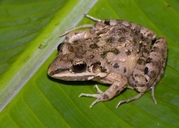|
Leptodactylus fragilis (Brocchi, 1877)
White-Lipped Frog W. Ronald Heyer1
Author's note: Leptodactylus fragilis has been cited historically as either L. albilabris (Metcalf, 1923, in part) or L. labialis (Mulaik, 1937; Maslin, 1963a,b; Dixon and Heyer, 1968; Heyer, 1971; Villa, 1972; Meyer and Foster, 1996; Levell, 1997; McCranie and Wilson, 2002). 1. Historical versus Current Distribution. White-lipped frogs (Leptodactylus fragilis) are known throughout lowland Middle America to the north coast of South America as far as Venezuela (Heyer, 1978, 2002). In the United States, these frogs marginally occur in southernmost Texas, specifically in the extreme southern edge of the Lower Rio Grande Valley (Garrett and Barker, 1987). They are known historically from one locality in Cameron County, two localities in Hidalgo County, and one locality from Starr County (Heyer, 1978). Dixon (1987, 1996) reported no new localities. 2. Historical versus Current Abundance. Dixon (1987, p. 66) commented: “This frog may be extirpated from Texas through the continuous dispersal of organophosphate chemicals in the Rio Grande Valley.” 3. Life History Features. A. Breeding. i. Breeding migrations. Males have been found calling under clumps of grass, dirt clods, and from small depressions (Garrett and Barker, 1987). ii. Breeding habitat. Brooding chambers, excavated by males, are found under rocks, logs, or debris in clay soil (Dixon and Heyer, 1968). Dixon and Heyer (1968) note that these chambers may contain calling males or foam nests. B. Eggs. i. Egg deposition sites. Eggs are laid in foam nests, created by body secretions, in small brooding chambers excavated by adults (Maslin, 1963a,b; Garrett and Barker, 1987). The foam aids in preventing desiccation of the eggs during development (Garrett and Barker, 1987). ii. Clutch size. A foam nest from Texas contained 86 yellow eggs (Mulaik, 1937). Villa (1972, p. 122) reported 25–250 eggs/nest. C. Larvae/Metamorphosis. Early development takes place in the foam nests within the brooding chamber; larvae are released to ponds during heavy rains (Dixon and Heyer, 1968). i. Length of larval stage. Mulaik (1937) reported a larval duration of 30–35 d in a Texas population. Meyer and Foster (1996) state that in Belize the tadpoles usually metamorphose in < 2 wk. ii. Larval requirements. Unknown. iii. Larval polymorphisms. None. iv. Features of metamorphosis. See "Length of larval stage" above. v. Post-metamorphic migrations. Unknown. D. Juvenile Habitat. Likely the same as adults. E. Adult Habitat. Adult white-lipped frogs have been found in a variety of habitats where moisture is sufficient (Garrett and Barker, 1987). These frogs can be found in semi-permanent water bodies such as prairie potholes, oxbow lakes, and resacas (Edwards et al., 1989). Garrett and Barker (1987) note that white-lipped frogs may be encountered in irrigated agricultural fields, irrigation ditches, low grasslands, and runoff areas. These frogs are nocturnally active and may hide in burrows during the day (Garrett and Barker, 1987). F. Home Range Size. Unknown. G. Territories. Males call in association with incubating chambers (Dixon and Heyer, 1968) and would be expected to defend these sites from other males, although this has yet to be documented. H. Aestivation/Avoiding Dessication. Unknown. I. Seasonal Migrations. Unknown. J. Torpor (Hibernation). Unknown and unlikely. K. Interspecific Associations/Exclusions. Unknown. L. Age/Size at Reproductive Maturity. Males reach a maximum length of 36 mm SVL, females 40 mm SVL (Heyer, 1971). M. Longevity. Unknown. N. Feeding Behavior. White-lipped frogs forage nocturnally in open areas (Garrett and Barker, 1987). O. Predators. Unknown. P. Anti-Predator Mechanisms. Unknown. Q. Diseases. Unknown. R. Parasites. Metcalf (1923) reported the ciliate opalinid Zelleriella leptodactyli from specimens from Tehuantepec, Mexico. 4. Conservation. Listed as Threatened, and therefore protected, by the State of Texas (Levell, 1997; www.tpwd.state.tx.us). Historically, white-lipped frogs are known from one locality in Cameron County, two localities in Hidalgo County, and one locality from Starr County (Heyer, 1978). Dixon (1987, 1996) reported no new localities and comments (1987, p. 66) “This frog may be extirpated from Texas through the continuous dispersal of organophosphate chemicals in the Rio Grande Valley.” McCranie and Wilson (2002, p. 533) state that white-lipped frogs are of low vulnerability in at least parts of their distribution. 1W. Ronald Heyer
Department of Vertebrate Zoology
National Museum of Natural History
Smithsonian Institution
P.O. Box 37012
Washington, D.C. 20013-7012
Heyer.Ron@NMNH.SI.edu
Literature references for Amphibian Declines: The Conservation Status of United States Species, edited by Michael Lannoo, are here.
Feedback or comments about this page.
Citation: AmphibiaWeb. 2024. <https://amphibiaweb.org> University of California, Berkeley, CA, USA. Accessed 20 Apr 2024.
AmphibiaWeb's policy on data use.
| 